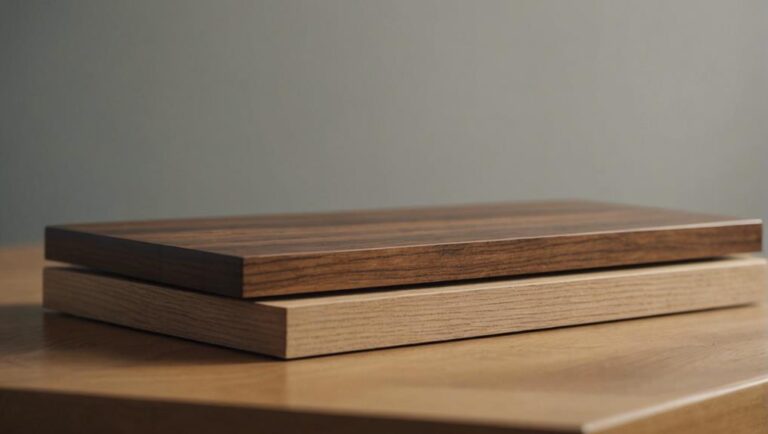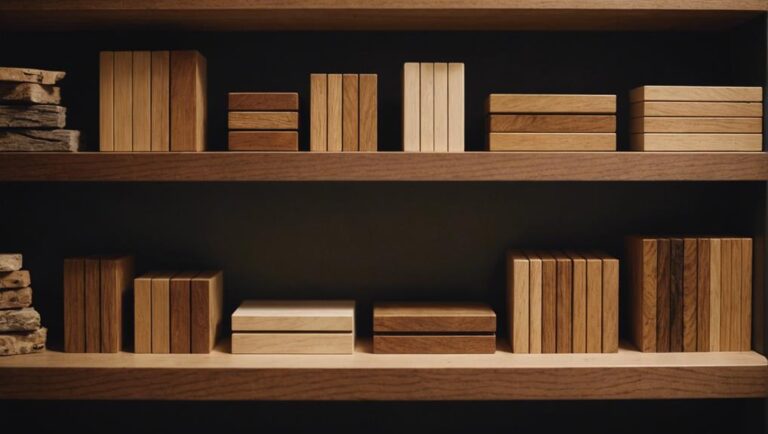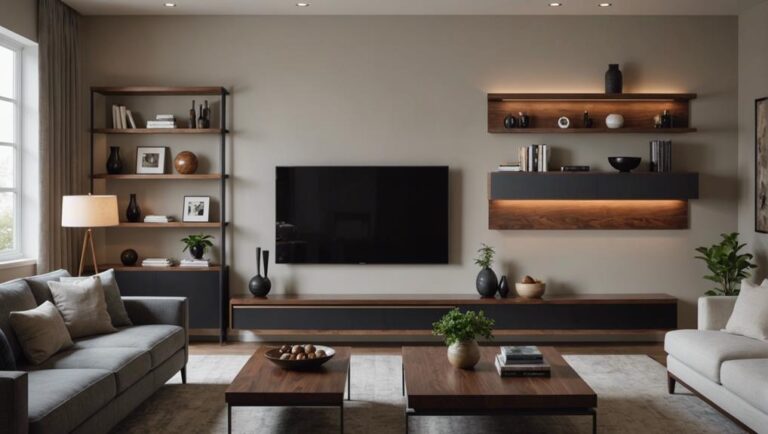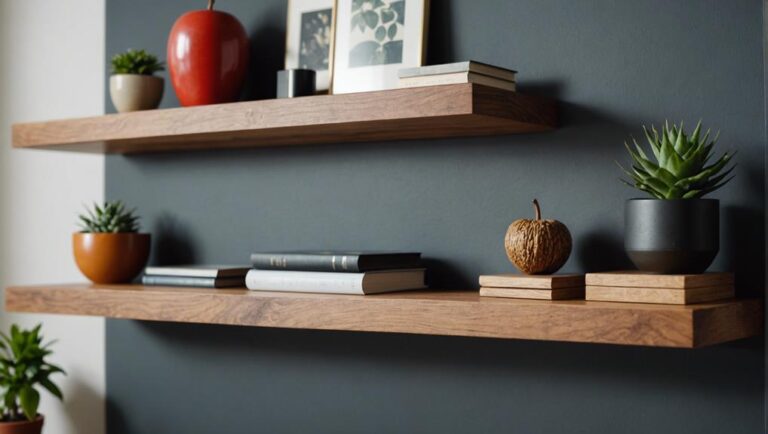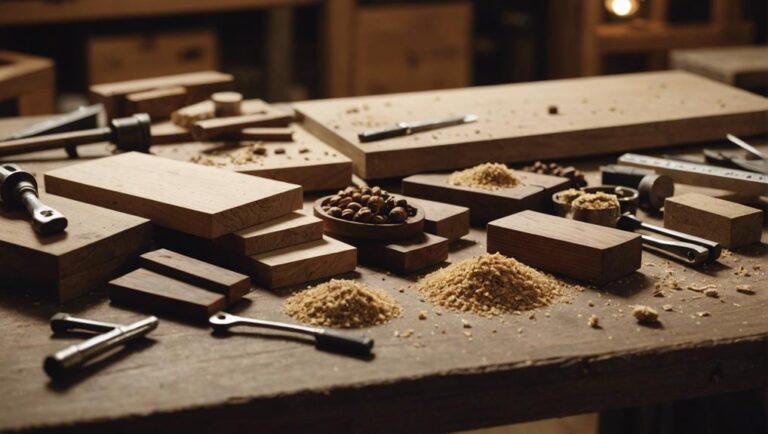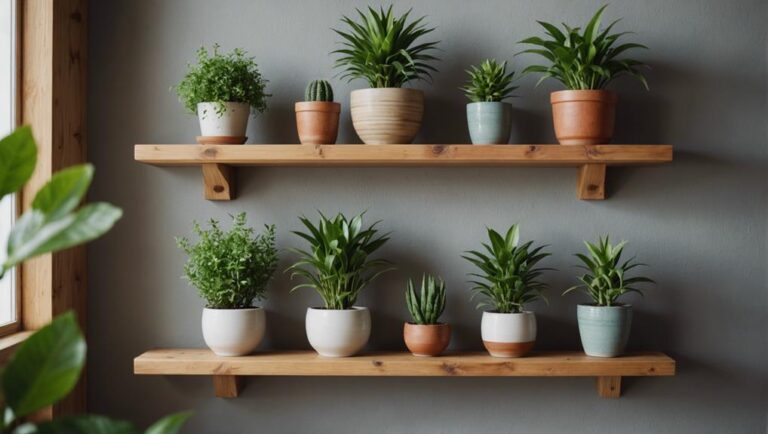Exploring Different Stains and Finishes for Wood Floating Shelves
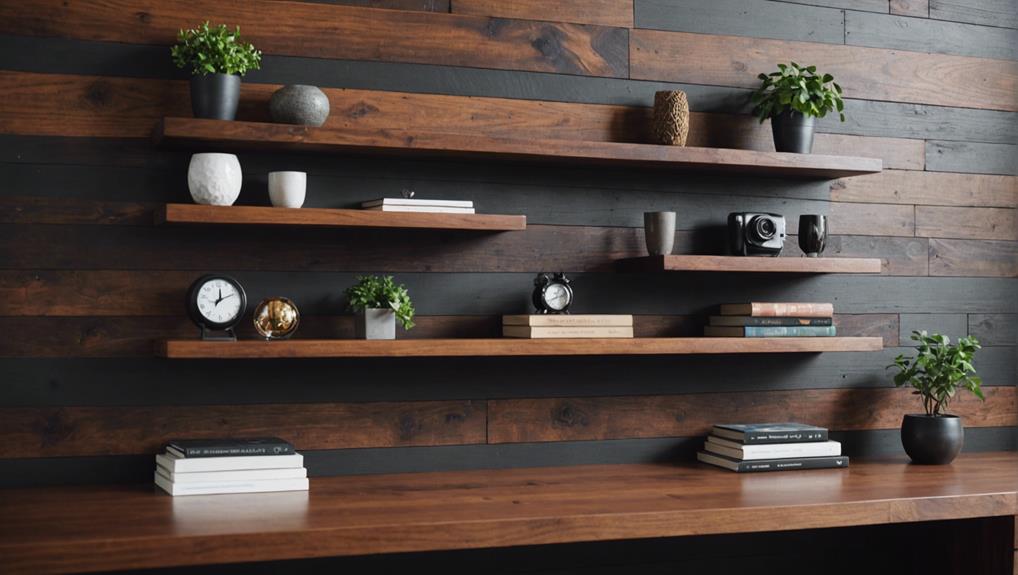
Exploring different stains and finishes for wood floating shelves allows us to blend style and resilience. Stains not only enhance the natural allure of the wood but also provide protection and a wide array of color options, ranging from subtle hues like Pecan to striking tones like Ebony. Choosing the suitable stain involves considering the wood's inherent tone and the lighting in the room. Thorough sanding is essential to ensure a smooth application, and it's advisable to test the stains on a small area beforehand.
In addition to stains, clear coats like matte, satin, and gloss play a crucial role in enhancing the aesthetics and safeguarding the wood. Each type of clear coat brings its distinct visual appeal and maintenance advantages.
Mastering these components will help you unveil a harmonious blend of beauty and durability in your floating shelves.
Key Takeaways
- Before applying any stains, it's crucial to test them on a small area of the wood shelf first. Different wood species have unique absorption rates, so testing helps ensure the desired color and finish.
- Opting for a satin finish on your floating wood shelves can provide a subtle sheen that enhances the overall look. Additionally, satin finishes are easier to maintain, making them a practical choice for shelving.
- To protect your wood shelves from scratches and bring out the natural beauty of the wood grain, consider using clear satin or matte top coats. These finishes not only add a layer of protection but also highlight the intricate patterns in the wood.
- When choosing a stain color for your wood shelves, consider options like Early American or Special Walnut. These neutral tones complement a variety of decor styles, making them versatile choices for floating shelves in different spaces.
- For a sustainable option, look for eco-friendly stains and water-based finishes for your wood floating shelves. These choices not only minimize environmental impact but also provide a safe and healthy option for your home decor.
Types of Wood for Shelves
Selecting the right type of wood for your floating shelves plays a crucial role in enhancing their appearance and durability. Each wood variety offers distinct characteristics that can completely transform the ambiance of any room. Pine is a popular choice for those seeking bold grain patterns, while its rustic, reclaimed option adds a dash of vintage appeal, ideal for infusing character into your space.
Alder wood presents another fantastic option, boasting a smooth, creamy finish. Whether you opt for rustic or premium Alder, each variation brings a unique texture and richness to the shelf it adorns.
If a modern, sleek aesthetic is what you desire, look no further than Maple wood. Its bright white hue exudes a contemporary vibe that effortlessly stands out in any cutting-edge home design.
For a timeless, natural look, White Oak wood remains a top contender, showcasing its unstained beauty that embodies classic style. On the other hand, Walnut wood mesmerizes with its deep, classic brown shade, introducing a touch of elegance and sophistication to your floating shelves.
Benefits of Wood Stains
Wood stains are a fantastic way to bring out the natural beauty of our floating shelves while also protecting them from wear and tear. By adding color and depth, wood stains can completely transform the look of our shelves, making them a standout feature in any room. They provide a unique opportunity to showcase the intricate grain patterns of the wood, highlighting details that might otherwise go unnoticed.
In addition to enhancing aesthetics, wood stains serve as a barrier against moisture and harmful UV rays, ensuring that our shelves remain sturdy and long-lasting. This protective layer is particularly crucial in environments with high humidity or direct sunlight, where untreated wood is susceptible to warping, cracking, or fading.
Furthermore, staining allows us to customize the appearance of our shelves to match our personal style and existing decor. Whether we prefer a light, airy feel or a dark, rich ambiance, selecting the right stain can help us achieve the desired look. This customization enables seamless integration with other furniture pieces, creating a cohesive and innovative design throughout our space.
Ultimately, wood stains offer a blend of beauty and practicality, ensuring that our shelves maintain their stylish appearance and functionality for years to come.
Choosing the Right Stain
When picking the perfect stain for our wood floating shelves, it's essential to consider the existing wood tones in our home. By selecting the right stain thoughtfully, we can ensure that our shelves complement the overall style of our space. Choosing a wood stain that blends with the current hues will add depth and harmony, creating a unified look.
Each piece of wood is one-of-a-kind, and elements like lighting can significantly influence how the stain is perceived. Therefore, it's important to take into account the following factors:
- Expert advice: Consulting professionals can offer valuable insights and personalized recommendations.
- Digital color samples: Examining digital swatches allows us to visualize how different stains will appear in our home.
- Customer photos: Real-world examples from other users can provide inspiration and practical perspectives on how various stains work.
In the process of selecting the ideal stain, we should explore popular options such as Early American, Special Walnut, Pecan, and Willowbend to achieve a customized appearance. It's crucial to keep in mind that the final look of the stain may vary, so conducting a test on a small, inconspicuous area of the wood is always a wise step.
Popular Stain Colors
Popular choices for stain colors on wood floating shelves often reflect a mix of classic neutrals and bold dark shades favored by homeowners. Neutral tones like light oak or puritan pine create a warm and versatile backdrop that complements various interior styles.
Conversely, opting for rich, dark shades such as walnut can provide a striking contrast and add a touch of sophistication to any room. When selecting a stain color for your wood floating shelves, consider the overall aesthetic of your space and how the color will interact with other elements in the room.
It's essential to choose a stain that enhances the natural beauty of the wood while also complementing the existing decor.
Classic Neutral Tones
When it comes to selecting the perfect wood species and finish for your floating shelves, classic neutral tones like Early American, Special Walnut, and Pecan stand out as timeless choices. These stains offer a harmonious blend of innovation and tradition, making them well-suited for a variety of wood types, including Pine, Alder, Maple, and White Oak.
The Early American stain infuses a golden light brown hue, exuding a sense of warmth and history that can elevate the ambiance of any space. It's an excellent option for those aiming to create a welcoming and cozy environment in their home.
If you're looking for a versatile and complementary option, the Special Walnut stain is a fantastic choice. With its light brown tone and warm undertones, it effortlessly fits into various interior styles, whether you have a modern loft or a rustic farmhouse, enhancing the natural beauty of the wood.
For a sophisticated and natural look that highlights the intricate grain patterns of the wood, the Pecan stain is ideal. It offers a medium-brown shade that exudes timeless elegance, perfect for those who appreciate the organic aesthetics of wood.
Bold Dark Shades
Exploring the bold and sophisticated allure of dark stains like Willowbend and Dark Walnut for your floating shelves brings a touch of elegance and sophistication that's unmatched. Willowbend, with its cooler dark brown and gray undertones, introduces a modern edge, while Dark Walnut's rich brown hue delivers a deep, luxurious feel.
The right dark stain can truly transform your space. For a contemporary look, Espresso and Jacobean offer a sleek, modern finish that complements minimalist decor beautifully. On the other hand, Ebony and Onyx stains create a dramatic contrast, making your floating shelves stand out as statement pieces.
Here's a quick comparison of popular dark stains:
- Willowbend: Cooler dark brown with gray undertones
- Dark Walnut: Rich, deep brown shade
- Espresso: Modern, luxurious dark brown
- Jacobean: Sleek, contemporary finish
- Ebony: Dramatic, bold contrast
Pairing these dark stains with light-colored walls or decor can create a striking visual impact. Embracing these bold shades can innovate and elevate your interiors, ensuring your floating shelves are both functional and a focal point in the room.
Applying Wood Stains
Applying wood stains to floating shelves enhances their beauty and allows the unique grain patterns of the wood to shine through. Selecting and applying the right stain can transform ordinary wood into a stunning focal point in any room. Wood staining isn't just about adding color; it's about celebrating the natural allure of different wood species.
Each wood species absorbs stain differently, which impacts the final appearance, highlighting the intrinsic beauty of the wood.
When applying the stain, consider the type of stain you're using – oil-based, water-based, or gel-based stains each have their unique advantages in terms of application ease and finish qualities. Furthermore, different wood species like oak, pine, and walnut absorb stains uniquely, resulting in varying final appearances. It's important to choose a stain that aligns with the overall aesthetic vision for the room to achieve the desired outcome.
Begin the staining process by thoroughly sanding the wood to ensure a smooth surface for even stain absorption. When applying the stain with a brush or cloth, work with the wood's grain to allow the pigment to penetrate deeply. Multiple coats may be required to achieve the perfect hue and desired effect.
Clear Coat Options
Clear coat options provide a protective layer that not only preserves the wood but also enhances its natural beauty. When choosing the ideal finish for our wood floating shelves, we've various clear coat options to consider.
Each type of clear coat serves to safeguard the wood while also highlighting its inherent charm in distinct ways. For a more subtle appearance, a matte clear coat offers a flat, non-reflective finish, perfect for minimalist designs where understated elegance is key.
On the other hand, a satin top coat strikes a balance between matte and gloss, providing a subtle sheen that adds depth and richness to the wood, ideal for showcasing the texture and grain without overpowering the space with excessive shine.
For a more striking effect, a gloss clear coat creates a shiny, reflective surface that accentuates the wood grain and brings a vibrant, polished look to our shelves. Each of these clear coat options enables us to customize our shelves to meet the aesthetic and functional requirements of our innovative spaces, ensuring durability and visual appeal.
Satin Vs. Gloss Finishes
When choosing between a satin or gloss finish for our wood floating shelves, it's crucial to consider factors like reflectivity, appearance, durability, and maintenance. Satin finishes offer a subtle sheen that's ideal for a contemporary and understated aesthetic, while gloss finishes provide a high shine that enhances a modern and luxurious look. Each finish has its own unique appeal, so it's important to think about which one best suits the style and feel we want to achieve in our space.
In terms of maintenance, satin finishes are generally easier to upkeep compared to gloss finishes. Satin finishes are less prone to showing fingerprints, smudges, and scratches, making them a practical choice for areas with high traffic. On the other hand, gloss finishes may require more frequent cleaning to maintain their shine and appearance.
Considering how much daily wear and tear our shelves will endure, it's essential to choose a finish that can withstand the demands of our space while still looking stylish and well-maintained.
Reflectivity and Appearance
Deciding between satin and gloss finishes for wood floating shelves significantly impacts their appearance and overall appeal. Satin finishes, known for their subtle sheen, reflect less light, resulting in a smooth, matte look that complements modern and contemporary designs.
On the other hand, gloss finishes offer a high level of reflectivity, creating a shiny, polished appearance that enhances the natural beauty of the wood and adds a touch of traditional elegance.
When making this choice, it's essential to consider the following factors:
- Light Reflection: Satin finishes create a refined ambiance by reducing light reflection, while gloss finishes increase light reflection, adding depth and richness to the wood.
- Aesthetic Goals: Satin finishes are perfect for those aiming for a modern and understated look, ideal for a minimalist style. Gloss finishes, on the other hand, cater to individuals seeking a more luxurious and classic vibe.
- Space Impact: Your choice of finish can significantly impact the feel of the space. Satin finishes bring a sense of tranquility, while gloss finishes can make the area feel more lively and dynamic.
Ultimately, the decision between satin and gloss finishes should align with your vision for the space, reflecting your unique style and desired atmosphere.
Durability and Maintenance
Durability and maintenance play a crucial role in the selection process when deciding between satin and gloss finishes for wooden floating shelves. Satin finishes, with their understated sheen, are adept at concealing flaws and are simpler to upkeep compared to gloss finishes. This makes them an excellent choice for areas with heavy foot traffic where fingerprints, water marks, and stains are common occurrences. On the other hand, gloss finishes, renowned for their brilliant shine and reflective properties, provide a visually striking aesthetic but may display scratches and smudges more prominently over time.
When choosing between these finishes, it's essential to balance the maintenance requirements with the desired visual impact. Satin finishes necessitate less frequent cleaning and can better withstand daily wear and tear. Gloss finishes, while offering a stunning appearance and light-reflective qualities, require more attention to preserve their pristine luster.
Here's a simple breakdown to help illustrate:
| Attribute | Satin Finishes | Gloss Finishes |
|---|---|---|
| Look | Subtle Sheen | High Shine |
| Concealment of Flaws | Excellent | Moderate |
| Upkeep | Low | High |
| Mark Resistance | High | Moderate |
| Ideal Setting | High-traffic areas | Low-traffic, visually striking spaces |
Protective Finishes
To ensure the longevity and durability of our wood floating shelves, it's crucial to apply a clear satin top coat. This protective finish acts as a shield against scratches, stains, and daily wear and tear, ultimately preserving the natural beauty of the wood with a subtle sheen.
Let's delve into why incorporating protective finishes is a game-changer for our floating shelf projects.
Protective finishes serve as a barrier that safeguards our shelves, keeping them in pristine condition for years, particularly in high-traffic areas where damage risk is elevated.
The clear satin top coat not only protects the wood but also enhances its natural aesthetic, adding a touch of sophistication without overwhelming the grain pattern. By uniformly applying these finishes, we ensure a consistent and high-quality appearance across all our wood floating shelves.
- Enhanced Durability: Protective finishes provide a defense against physical damage.
- Aesthetic Preservation: Maintains the natural beauty of the wood with a subtle sheen.
- Consistency: Ensures a uniform and high-quality look throughout all shelves.
Enhancing Wood Grain
Enhancing the wood grain with stains not only showcases the natural patterns and textures but also adds depth and character to our floating shelves. Stains penetrate the wood, emphasizing its intrinsic beauty and complexity. By carefully selecting the right stain color, we can accentuate the wood grain underneath, making it more prominent and visually appealing. This process allows us to bring out unique characteristics that might otherwise go unnoticed, transforming the look of our shelves.
The choice of stain color is crucial in enhancing wood grain. Whether opting for a light, translucent stain to highlight intricate grain patterns or a darker, richer hue to create contrast and drama, each option plays a significant role in the overall aesthetic. Experimenting with various stain options enables us to customize our shelves, adding a personalized touch that aligns with our design vision and preferences.
Enhancing wood grain goes beyond just aesthetics; it's about recognizing the craftsmanship and natural elegance of the material. Through thoughtful selection and application of stains, we can breathe new life into our floating shelves, turning them into focal points in any space. This approach ensures that each shelf not only serves a functional purpose but also serves as a reflection of our design sensibilities, adding a touch of sophistication and style to our living spaces.
Matching Home Decor
When selecting wood floating shelves to match our home decor, it's essential to consider the existing wood colors to ensure that our choices enhance the overall style cohesion. Opting for complementary hues rather than exact matches can create a more dynamic and visually appealing atmosphere in our living space. This approach not only seamlessly coordinates colors but also contributes to a balanced and cohesive look.
To achieve this harmonious blend, it's important to choose wood species and finishes that complement the existing tones in our home. By selecting wood species that harmonize with the dominant wood colors in our decor, we can create a cohesive and unified aesthetic. For example, if our existing furniture features warm oak tones, choosing floating shelves in a similar warm wood species like cherry or walnut can help tie the room together.
Furthermore, considering the finish of the wood floating shelves is crucial in ensuring a cohesive look. Opting for finishes that either match or complement the existing wood finishes in our space can help create a seamless transition between the shelves and the rest of the decor. Whether it's a matte, glossy, or distressed finish, selecting a finish that aligns with the overall style of the room can enhance the visual appeal of the shelves.
Coordinating Colors Seamlessly
Considering the existing wood colors in our home is essential when selecting stain colors for floating shelves that seamlessly complement our decor. By taking into account the tones already present, we can ensure that our new shelves enhance rather than disrupt the aesthetic flow of our living spaces.
Effective color coordination goes beyond simple matching; it's about creating a sense of balance and harmony.
When choosing the right stain, it's important to:
- Blend Well with Overall Scheme: Ensure that the stain color blends smoothly with the primary color palette of the room.
- Avoid Exact Matches: Opt for complementary hues instead of identical shades to maintain visual interest and prevent monotony.
- Enhance and Balance: Select stains that not only complement but also elevate the existing decor elements.
Innovating in home decor involves thinking beyond traditional matching. The goal is to create a dynamic interplay between different wood colors, adding depth and character to our space. By thoughtfully coordinating colors, we can achieve a cohesive look that feels intentional and sophisticated. This approach allows the floating shelves to seamlessly blend with our home's design, merging practicality with style.
Enhancing Style Cohesion
To create a cohesive look in our home decor, it's important to carefully consider the wood stains we choose for elements like floating shelves. By taking into account the existing wood tones in the space, we can ensure that any new additions enhance the overall aesthetic rather than clash with it. Achieving a balance between these wood tones is key to creating a visually appealing and unified environment.
Instead of going for exact matches, it's advisable to select stain hues that complement each other, adding depth and interest to the decor. This approach not only prevents a dull, uniform appearance but also fosters a more dynamic and captivating atmosphere.
For example, if the flooring boasts rich, dark wood tones, opting for floating shelves with a slightly lighter stain can introduce a subtle yet intentional contrast that exudes style.
It's crucial to understand that matching wood stains doesn't equate to everything being identical. The goal is to cultivate harmony and equilibrium, ensuring that the various wood elements coexist harmoniously without conflicting. This mindful approach allows for the incorporation of innovative design features while upholding a seamless, cohesive look that ties the room together effortlessly.
DIY Staining Tips
When designing floating wood shelves, selecting the right wood species and finish is crucial for achieving a stylish and functional look. Start by considering the characteristics of different wood species to determine the best fit for your space. Oak, known for its durability and grain patterns, is a popular choice for a timeless and sturdy shelf.
On the other hand, cherry wood offers a rich color and smooth finish, ideal for adding a touch of elegance to your decor.
To enhance the aesthetic appeal of your floating shelves, choosing the right finish is essential. Opt for a clear, matte finish to maintain the natural beauty of the wood while providing protection against moisture and scratches. A satin finish offers a subtle sheen that adds a touch of sophistication without being too glossy, perfect for a modern and sleek look.
Common Staining Mistakes
When staining wood floating shelves, it's essential to properly prepare the surface to ensure an even finish. Inadequate surface preparation can result in a patchy appearance that detracts from the overall aesthetic.
Additionally, allowing sufficient drying time between coats is crucial. Failure to do so can lead to a sticky or tacky surface, compromising the final look of the shelves.
Inadequate Surface Preparation
Properly preparing the surface is crucial for achieving a flawless finish when staining wood floating shelves. To start, ensure the wood is thoroughly sanded to avoid rough patches that can lead to uneven stain absorption. Skipping or rushing through this step can result in an inconsistent appearance.
Using a wood conditioner is another vital aspect of surface preparation. This product helps seal the wood's pores, promoting a more uniform application of the stain. Neglecting this step may result in splotchy and irregular finishes that take away from the shelves' aesthetic appeal.
Before applying any stain, it's essential to remove all dust and debris from the surface. These particles can cause imperfections and blemishes, affecting the final look of the shelves.
By following these steps diligently:
- Proper Sanding: Smooth out any rough patches for consistent stain absorption.
- Wood Conditioner: Seal the wood pores to prevent blotchy finishes.
- Dust Removal: Eliminate particles to avoid imperfections.
Uneven Stain Application
Uneven stain application is a common issue that can significantly impact the visual appeal of our wood floating shelves, leading to a blotchy and unprofessional appearance. This problem often arises due to inadequate surface preparation or inconsistent application techniques.
To avoid uneven staining, it's crucial to meticulously prepare the surface by thoroughly sanding the wood to ensure a uniform texture.
Even if the surface is well-prepared, uneven color distribution can still occur if the stain isn't properly mixed before application or if it's applied inconsistently. Factors such as variations in wood porosity and moisture content can also contribute to uneven stain absorption, resulting in some areas appearing darker than others.
Another factor that can lead to uneven color distribution is the pooling of stain in certain spots, which occurs when excess stain isn't promptly wiped off.
To prevent this issue, it's important to apply the stain evenly and consistently, ensuring that any excess is immediately removed to achieve a smooth and uniform finish on our wood floating shelves.
Ignoring Drying Time
Neglecting the drying time can ruin our wood floating shelves, resulting in a sticky and uneven finish. It may be tempting to rush through the process, eager to see the final product, but patience is crucial. Proper drying time ensures that the stain sets correctly and the top coat application is smooth and flawless.
Disregarding drying time can lead to various issues:
- Sticky Surface: Insufficient drying time leaves the surface tacky, making it susceptible to gathering dust and debris.
- Uneven Appearance: Hastiness can cause the stain to settle unevenly, leading to a blotchy and unattractive look for the shelves.
- Potential Long-term Damage: A subpar finish can compromise the wood's durability, resulting in accelerated wear and tear.
Different stains and finishes have different drying times, so it's essential to follow the manufacturer's instructions diligently. Allowing each layer to dry completely helps us achieve a professional and long-lasting finish on our wood floating shelves. This attention to detail not only enhances the aesthetic appeal but also ensures the shelves' longevity.
As pioneers in our field, we must prioritize the drying process as much as the application itself. Let's embrace patience and precision to elevate our wood floating shelves into exquisite works of art.
Maintenance of Stained Shelves
Maintaining stained shelves requires regular dusting with a soft, dry cloth to keep them looking their best. Dust can gradually dull the appearance of wood surfaces, so a gentle wipe-down is key to preserving their shine. Harsh chemicals and abrasive cleaners should be avoided, as they can harm the finish on stained shelves. Instead, opt for a wood-specific furniture polish to enhance the natural beauty of the shelves without causing any damage.
Spills are bound to happen, but quick action is crucial. Immediately wipe up any spills with a damp cloth to prevent stains or water damage. This proactive approach helps to prolong the life of stained shelves, as water and wood don't mix well and should be kept apart.
To maintain stained shelves in top condition for the long term, consider periodically reapplying a clear coat or top coat. This not only protects the finish but also preserves the initial luster that attracted us to these exquisite pieces.
Eco-Friendly Stains
When considering the design of floating wood shelves, it's important to carefully select the wood species and finish to achieve the desired aesthetic and functionality. Each wood species has its unique characteristics, such as grain patterns and color variations, that can impact the overall look of the shelves. Popular wood species for floating shelves include oak, walnut, and maple, each offering a distinct appearance and durability.
Oak is known for its strength and prominent grain patterns, making it a popular choice for floating shelves that require sturdiness and a traditional look. Walnut, on the other hand, boasts a rich, dark color and a luxurious appearance, perfect for adding a touch of elegance to any space. Maple is lighter in color and features a smooth grain, ideal for creating a modern and minimalist design.
When it comes to selecting a finish for floating wood shelves, there are various options to consider, such as natural oils, water-based finishes, or eco-friendly stains. Natural oils enhance the natural beauty of the wood while providing protection against moisture and wear. Water-based finishes are low in VOCs and offer a clear, durable coating that's safe for indoor use.
Opting for eco-friendly stains not only adds a touch of sustainability to your shelves but also ensures that your living environment remains healthy and safe. These stains, derived from natural ingredients like plant oils and waxes, are non-toxic and biodegradable, making them an environmentally conscious choice for finishing your floating wood shelves.
Custom Stain Solutions
Custom stain solutions offer us the flexibility to perfectly match or complement the existing wood colors in our home. With a variety of stain colors like Early American, Special Walnut, Pecan, and Willowbend to choose from, we can achieve a personalized touch that reflects our unique style.
Beyond colors, exploring unique finishes like white wash, sand, or Puritan Pine allows us to create the desired aesthetic.
The staining process involves meticulous steps such as sanding the wood to a smooth finish, applying the chosen stain, and sealing it with a clear satin top coat for durability and a polished look. This ensures that our floating shelves not only look stunning but also withstand the test of time.
Selecting the right wood types is equally essential. Wood species like Pine, Alder, Maple, White Oak, and Walnut each offer distinct grain patterns and characteristics. These elements play a significant role in how the stain will appear once applied, allowing us to tailor the final look precisely to our preferences.
In essence, custom stain solutions empower us to transform our floating shelves into bespoke pieces that seamlessly integrate with our home's decor, reflecting both innovation and craftsmanship.
Frequently Asked Questions
How Do You Stain Wood Floating Shelves?
We cut and sand the wood to prepare it for staining. Then, we apply the chosen stain using innovative techniques that enhance the natural beauty of the wood. To finish, we add a clear satin top coat for a long-lasting, high-quality finish that will protect the wood and keep it looking beautiful for years to come.
When choosing the wood species for your floating wood shelves, it's important to consider the characteristics of each type of wood. For example, oak is known for its durability and grain pattern, while maple offers a smooth, uniform appearance. You can also consider exotic woods like mahogany or cherry for a unique and luxurious look.
When selecting a finish for your floating wood shelves, you have a variety of options to choose from. A clear finish will highlight the natural beauty of the wood, while a stain can add color and depth. You can also consider a matte, satin, or glossy finish depending on the look you want to achieve.
What Is the Best Stain for Wood Shelves?
When selecting the best stain for wood shelves, it's essential to focus on durability and color consistency. Popular choices like Early American and Special Walnut are known for their long-lasting finish, ensuring that your shelves maintain a fresh and cohesive look with your overall decor.
When it comes to floating wood shelf design, the choice of wood species and finish plays a crucial role in the overall aesthetic and functionality of the shelves. Different wood species like oak, walnut, or pine offer unique characteristics in terms of grain pattern, color, and durability. Oak, for example, is known for its strength and prominent grain, while walnut offers a rich, dark tone. Pine, on the other hand, is a softer wood with a lighter color that can be easily stained to achieve the desired look.
In addition to selecting the right wood species, choosing the appropriate finish is equally important. A stain like Early American or Special Walnut can enhance the natural beauty of the wood while providing protection against wear and tear. It's essential to consider the overall style of your space and the desired level of maintenance when deciding on the finish for your floating wood shelves.
How to Choose Floating Shelf Color?
When selecting the color for your floating wood shelf, it's essential to take into account your existing decor and color scheme. Opt for hues that complement your space's aesthetic, rather than exact matches, to create a more dynamic and innovative look. Finding a balance between the shelf color and the surrounding environment is key to achieving a cohesive and visually pleasing design.
Consider the wood species and finish of the floating shelf as well. Different wood species, such as oak, walnut, or pine, can bring unique characteristics to the shelf, like grain patterns and natural color variations. The finish, whether it's stained, painted, or left natural, can also significantly impact the overall look and feel of the shelf.
How Do You Make Floating Shelves Look Good?
Looking to enhance the appearance of your floating shelves? Consider incorporating decorative brackets for a distinctive touch. By selecting brackets with unique designs or finishes, you can elevate the overall aesthetic of your shelves and make them stand out as a focal point in the room.
When it comes to styling your floating shelves, it's essential to strike a balance between functionality and visual appeal. Mix and match books, plants, and art pieces to create an eclectic and personalized look. This combination not only adds visual interest but also allows you to showcase your personality and interests through the items you choose to display on the shelves.
Forget the notion that shelves are merely for storage – they can also serve as a statement piece in your space. By carefully curating the items you place on your floating shelves and paying attention to details like decorative brackets, you can transform them into a design feature that complements your overall interior aesthetic. Let your shelves reflect your style and creativity, making them a conversation starter for anyone who enters your home.
Conclusion
In the realm of floating wood shelf design, selecting the right wood species and finish is paramount.
Custom stain solutions offer a touch of individuality, with 90% of homeowners favoring this personalized approach.
The choice of stain not only enhances the aesthetic appeal but also plays a crucial role in prolonging the durability of the shelves.
Opting for eco-friendly products and committing to regular maintenance not only safeguards the wood but also contributes to a sustainable environment.

